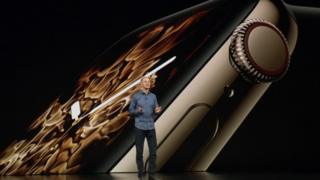 Image copyright Apple
Image copyright Apple
Apple has revealed a new version of its smartwatch featuring a display that extends further towards its edges.
The firm said the Watch Series 4’s usable screen is now more than 30% larger despite the device itself having similar dimensions to its predecessor.
The device has also gained the ability to detect if its wearer has fallen.
The firm is also expected to unveil new handsets based on the design of the iPhone X later at its California press event.
Apple overtook Xiaomi and Fitbit to become the world’s bestselling wearable tech company in the second half of 2017 thanks to strong demand for the last generation of its smartwatch. It has held on to the top spot ever since, according to IDC.
 Image copyright Apple Image caption The bigger screen allows more information and shortcuts to be shown at once
Image copyright Apple Image caption The bigger screen allows more information and shortcuts to be shown at once
“The reason it performed so well is that many network operators are only willing to focus on smartwatches with their own [built-in cellular] connectivity,” commented IDC’s Francisco Jeronimo.
“That’s why they are shipping about as many watches as the whole Swiss watch-making industry.”
New iPhones
There had been concerns that the relatively high £999 entry price of the handset would limit its appeal when it was announced a year ago.
But Apple said it had consistently proven more popular than either of the lower-priced iPhone 8 models. Market research firms suggest it also outsold rival companies’ flagship devices.
That helped propel Apple to become the world’s first company with a market capitalisation above $1tn (£768m).
However, China’s Huawei still managed to overtake it in terms of overall smartphone market share in the April-to-June quarter, putting Apple into third place.
“Huawei was able to overtake it because Apple is not playing in the mid and low ends of the market,” commented Francisco Jeronimo from IDC.
“But Apple is very well positioned in the premium segment, and we don’t expect that to change over the next 18 months.”
iPhone demand grows despite Chinese gains


IBM Simon: The first mobile phone to offer a touchscreen user-interface – but its battery only lasted an hour.
Siemens S10: The first handset with a colour display – although only red, green, blue and white could be shown.
LG Prada: The handset debuted a capacitive touchscreen – detecting finger taps by changes in the display’s electrical field rather than pressure.
iPhone: Apple made use of “multi-touch”, detecting several points of contact – allowing pinch-to-zoom and other interactions.
Nokia N85: First phone with an OLED (organic light-emitting diode) display, letting it show deeper blacks and better contrast.
Samsung Galaxy Note: Although not the first “phablet”, the handset proved there was demand for a 5+ inch display, despite claims it was “comically huge”.
LG G Flex: The curved design was derided as being a gimmick, but points the way to the true “bendy” phones of the future.
Sharp Aquos Crystal: The phone’s “edgeless” look foreshadowed today’s trend to keep bezels to a minimum.
Samsung Galaxy Note Edge: Samsung’s first handset to wrap its screen over one its sides used the extra space for notifications and app shortcuts.
Sony Xperia Z5 Premium: The smartphone premiered a 4K display before it was easy to obtain such ultra-high definition mobile content.
Essential Phone: The start-up beat Apple to featuring a camera notch in its display, which allowed the rest of the screen to extend upwards.
Vivo X21: The Chinese firm beat rivals to offering a fingerprint reader beneath its screen.






